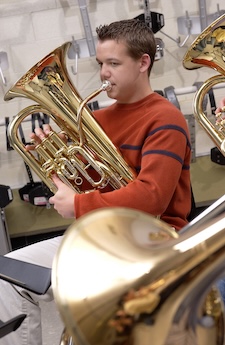Monday, April 15, 2024
What are the current goals for your ensemble(s)? Do any of them involve playing in TONE, in TUNE, and in TIME (in TTT)?
Simply stating that you would like your ensemble to play in TTT is outcome focused. There is a desired result in mind, but how are you going to get there? The first step is to build a system of processes that will move the needle towards playing in TTT. What routines, habits, and systems should you implement to achieve your desired outcome?
We get by with a little help from our friends! Don't be afraid to talk with other directors about playing in TTT. With social media, email, video conferencing, etc., communication with colleagues is easier now than ever. For example, in preparation for this article, I sent out an email asking for thoughts on playing in TTT and had several responses within a few hours! Below, I have linked a compilation of some directors' thoughts along with their contact email if you would like further explanation. I have also linked a goal-setting guide by James Clear. If you want more on the topic of habits, I HIGHLY recommend his book, Atomic Habits.

I'm sure most of us have done this at least once in our career...move a trumpet player (or _____ player) to euphonium/baritone. The clef and fingerings are the same as trumpet, right?
Usually, we execute this transfer because either our band's low brass section needs a boost, or we have a fledgling trumpeter that hasn't ever played above second line G, and we think a bigger mouthpiece will help. Either of these interventions, while valid, may be the primary reason we have euphonium players in our band.
While the euphonium does help to reinforce the low wind sound, its unique tone provides a key timbre to the "middle" of the band. The euphonium sound can blend with and fill out musical lines from clarinet to French horn. Also, many accomplished composers recognize the euphonium as solo-worthy.
As you look to future beginning band classes consider the euphonium/baritone as part of your instrumentation if possible. From day one the student(s) can develop as a euphonium player. If you start them on a smaller bore instrument (3 valves), try to move them to one with a larger bore (4 valves) before high school. In addition, moving them to a larger mouthpiece with a deeper cup (like a Schilke 51D) will help the student, over time, to produce a characteristic euphonium sound. Of course, each student's development/maturity will help guide your timeline. (Also, I moved my euphonium and trombone players from the standard issue 12C mouthpiece to a larger 6.5AL as soon as possible to help with better tone production).
Transferring a student from another instrument to euphonium does NOT mean they cannot develop into a euphonium player that will benefit your band. However, as we know, most students' chances of success over the long haul improve if they stay with the instrument they started on.
Good luck!
| (417) 882-7000 | (573) 256-5555 | (816) 792-8301 |
| (417) 781-3100 | (405) 896-8111 | (479) 464-8877 |
| (918) 286-1555 | (636) 229-1904 | (913) 234-4454 |
| (316) 262-1487 | (417) 882-7000 |
